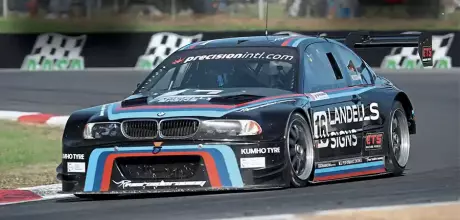780hp Chevrolet 6.0-litre V8 engined BMW M3 E46 racing machine
Take the front of one E46 M3 and the rear of another, weld them together, add some state-of-the-art mechanical components and a mighty V8 power plant – and you have a car that is hard to beat in any company.
THUNDER DOWN UNDER
Words: Richard Holdsworth
Photos: Chris Barbour, John Lemm, Richard Holdsworth, Liam Hill
This extreme 780hp V8-powered E46 M3 racing machine is an awesome creation that truly delivers on track.
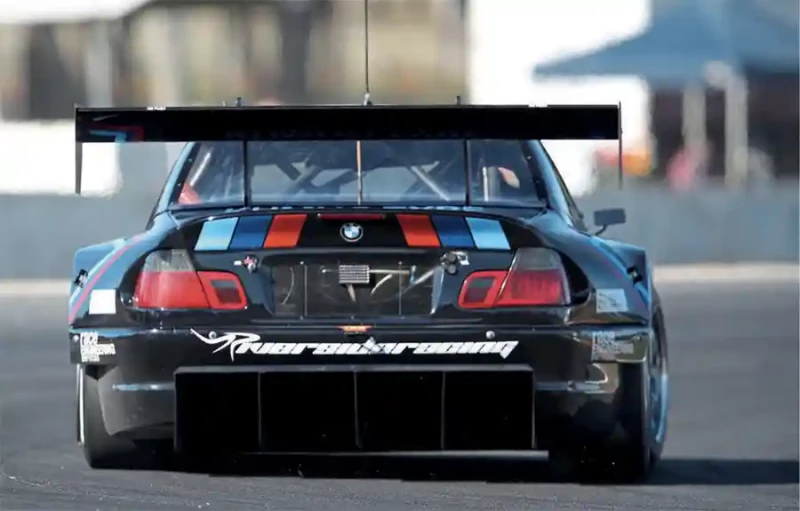
While this racing machine might look like an E46 M3 on the outside, in reality, there is not much beneath the bonnet that belongs to the famed Munich car manufacturer – but the car runs with a BMW badge and, as such, wows the crowds on tracks around Australia. And it is all down to Shane Woodman, the M3’s owner and driver, and Liam Hill and his team at Riverside Racing, the creators of the car. Put all these elements together, and you have a package that is rarely absent from the podium in Sports Sedan racing, a series unique to Australia and which grips fans for its sheer ferocity of power, speed and never-say-die competition. Shane Woodman had already proven himself on the race track and in rallies. He had followed Australian Touring Car racing for as long as he can remember.
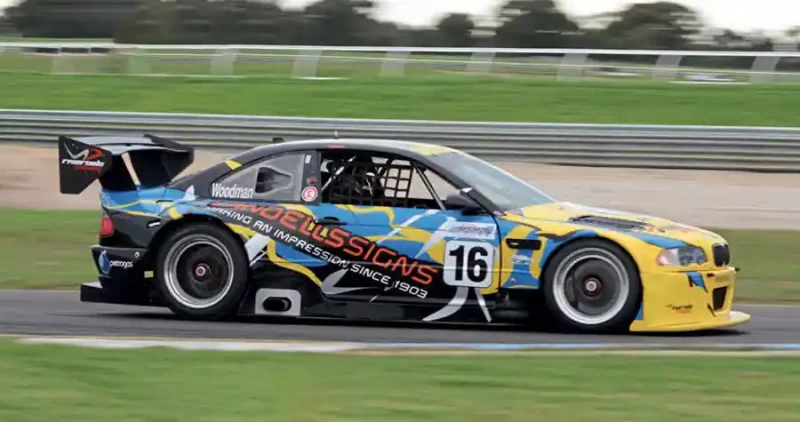
Family came first and then running a company that covered Australia, so it wasn’t until 2005 that Shane, at 35, took the plunge and bought a Ford Capri and started competing in Sports Sedan track races. The car had a full tubular chassis and was powered by a 350hp Chevrolet engine, very “old-school,” in his words, but the perfect car as an introduction to this form of racing. The Ford was joined by a more competitive car, a Holden built by the Australian wing of General Motors. The Holden Torana A9X had raced at Australia’s nationgripping marathon, the Bathurst 1000, and had enjoyed success. Shane set about restoring the car and entered it in the Targa Tasmania Rally while retaining the Capri for circuit racing.
Inevitably, parts were needed for both cars, and a crash in the Capri brought Shane to Gary Gunn at Riverside Racing in Melbourne. And at Riverside Racing he met up with Liam Hill, a young man making a name for himself with an abundance of skills and enthusiasm. When Gary retired in 2021, Liam took over, cementing the relationship with Shane. And it was Liam and Riverside Racing that Shane turned to when he wanted something new and really potent. Liam was asked to create, design and build a new race car from scratch, and that is the car we are discovering here today, one that proudly carries the BMW badge on its bonnet.
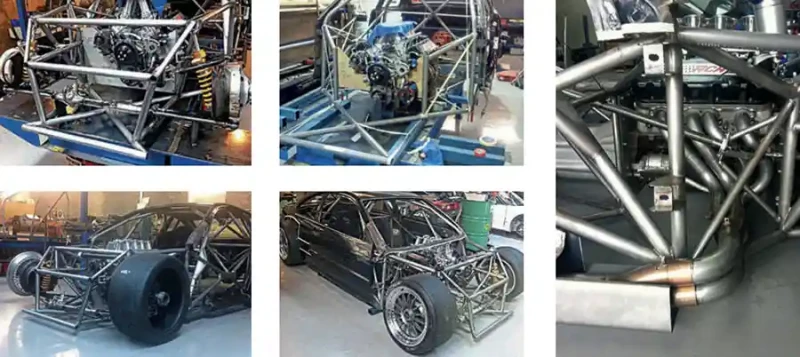
The cooperation between the two men and the two companies has developed, and this makes such a formidable team. We’re sitting with these two good men at the base in Melbourne and delving into the history that results in a BMW-badged car reaping such success in Australia’s incredibly competitive Sports Sedan Series. Liam takes up the story. “A BMW has this pedigree in motor racing, not the least in Australia where one of the most illustrious names in the sport, Jim Richards, beat factory-backed teams from across the world with a E24 635CSi followed by an incredible M3.”
This opposition has seen the perennial battle between two of Australia’s giants on the track – Holden and Ford – but a quick glance down the entry list at a recent race meeting we attended at Sandown, Melbourne’s premier circuit, also showed some exotic names including Alfa Romeo, Audi, Chevrolet and even an Aston Martin Vantage V8.
Liam again: “Shane gave me free rein to create a car that would compete with the best – as long as I adhered to four simple provisos: a glass windscreen (polycarbonate might be lighter, but nothing beats glass for clear vision), the car had to fit in Shane’s race transporter and, of course, it had to carry the BMW badge – and it had to be quick!” The year was 2013, and the die was set – the two men were setting out on a challenge to put the BMW name at the forefront of Australia’s spectacular Sports Sedan racing series.
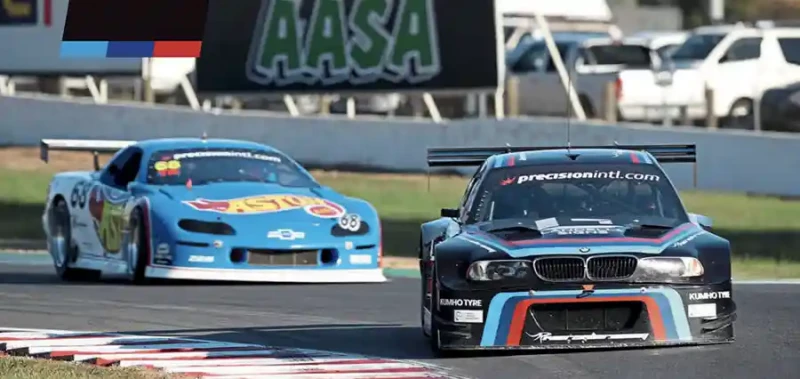
The regulations for the series allow wide-ranging freedom for the design engineer, resulting in much of the manufacturer’s original mechanical components being ditched. The engine, being the heart of the matter, is the first to go. Engines are invariably sourced in the States, where NASCAR race engines are built by the dozen. It is such an industry, and the competition is so intense and rewarding (for the winners) that the top guys change engines like most people change their socks and an engine that has probably only raced once is considered past its peak and ready for a strip down. Often, an engine is given a top-end overhaul after 1500km on the track and a full overhaul after 4000 km in the heat of competition.
Brand new engines can cost as much as $140,000 – secondhand can be picked up for a lot less, and that’s what Shane and the team did – not just securing one, but two, through their contact in the States, Richard Childress Racing. Their choice was the Chevy V8 SB2.2 engine: six litres (the limit for Aussie Sports Sedans) and giving around 780 to 800 horsepower on test – a Sunday afternoon drive, this is not! And don’t expect this muscle power to be located in the customary up-front position – it is moved back into the driver’s cab to get a better front-to-rear balance, often pinching the space normally allocated for the man at the wheel.
Next, Shane and Liam looked at the car’s body – clearly, they weren’t going to buy a new or even second-hand M3 and throw away ninetenths of the parts just to get the BMW’s iconic shape. While most others spent weekends following their favourite football team or tending their gardens, the two scoured wreckers’ yards around Melbourne. It was proving unsuccessful until they came across a car that had suffered a rear shunt. The front was undamaged… it got them thinking of an identical car they had seen but with a front that had taken a battering – the back was perfect. Hey presto, the BMW M3 front and back were ‘married’ over the next few weeks and looked as though they had never been apart.
But that’s only the start for Liam and the guys at Riverside Racing – all that metal was heavy, and if they were to complete on equal footing with the other Sports Sedans, they would have to do as they did, replicating the M3 shape but in fibreglass. Of course, this gave an excellent opportunity to look at improving the aerodynamics of the original road-going M3 and the obvious changes to the body that would make it a competitive race machine – this is where more of Liam’s skills came into play.
First, he fashioned giant wheel-arch flares, then huge air dams to provide downforce to the front and giant wings to the rear. Scott Beeton, the former aerodynamicist for the Williams Formula One team in the UK and now established in Australia with his own company, AeroDesign Pty Ltd, was brought in at one stage to create an even more slippery shape and one which would give more downforce and transmit all that V8 power to the back wheels and then to the track.
The body was then spraypainted to a smooth finish before being laid up with fibreglass and a ‘female’ mould taken in fibreglass – then casting a ‘male’ body from that. The result was a fibreglass body to the exact shape that Liam and his panel beaters had created – but saving many kilos in weight. The other advantage, of course, was the fact that future bodies – or parts of bodies – could be taken from the female mould should damage occur on the track. Later, fibreglass became history as the leading Sports Sedan racers replaced it with carbon fibre – and that is how Shane’s M3 now appears on track. The carbon fibre body, along with other modifications, eventually slimmed the car down by another 75kg. Now they really were getting somewhere!
Obviously, a fibreglass or even a carbon fibre body can’t support itself, especially with some 700- plus horsepower to deal with, and this is where freedom in the regulations had to be grasped to the full, and a tubular space-frame chassis became an essential backbone to the car. This was created at Riverside Racing using state-of-the-art technology, and Liam’s experience picked up over the past 10 years working under Gary Gunn. “I didn’t have blueprints to work to, none whatso- ever,” Liam tells us with a smile. “Just what I had picked up in the past, plus an enormous amount of midnight oil in the workshop. The aim, obviously, was to keep weight down along with perfect weight balance, aerodynamic integrity and uncompromised suspension allround.
And not forgetting creating a car that is easy to work on when Shane comes off the track and into the pits and urgent work has to be done. Seconds count at this level.” As explained, Shane Woodman was no newcomer to the race track with the Capri, but the M3 was a totally different kettle of fish – much more power, vastly better suspension, brakes and aerodynamics. The full potential had to be explored, and they used the first year, 2013, as a shakedown for what was to come. Just two rounds of the State championship – the ‘home’ track at Sandown, close to base in Melbourne, and then, the traditional Classic Car weekend on Phillip Island, some 50 miles south on Port Philip Bay, bordering the Southern Ocean. The two outings enabled Liam and Shane to identify any problems and carry out a degree of de-bugging. In Liam’s words, “Getting in the car in the engineering window…”
With just these two races behind them – plus the hours of testing – Shane and the M3 staked all on entering the full 2014 racing season – and what a season it proved to be, winning the Victorian State Championship on tracks across the state of Victoria including Winton, Sandown and another visit to Phillip Island. Champagne at the end of the day!
Now to tackle 2015 and move up to the Australia-wide National competition with the best in Australian Sports Sedans and races in Queensland, New South Wales and back home in Victoria with visits to the Sandown track and again at Phillip Island. The result – a very creditable sixth place among the big boys and cars honed to this highly competitive category of Australian track racing. In short, it was a massive achievement for Shane, Liam and a car carrying the BMW badge to come home so high up the ladder and ahead of more seasoned campaigners.
But sixth is sixth – these Aussies are tilting their caps at more than that and the year 2016 was used to take a hard look at where they were and what they had to do to get closer to the chequered flag. One of the things was aerodynamics, and that was time to bring on board Scott Beeton, who had been involved with aerodynamics at Williams F1 in the UK. Scott ‘breathed’ on the aerodynamics of the car with special emphasis on the underside to make it more effective. This not only gave it a smoother flow of air over the car but added to the downforce with a series of venturis to increase airspeed, in effect sucking the car to the ground. This was the year that the fibreglass body was ditched, and in came carbon fibre, encompassing, of course, Scott Beeton’s work.
It says much for the highly competitive nature of motor racing that the next season’s racing became one of understanding the changes to the car, perfecting these changes and taking full advantage on the track. 2017 was almost a case of trial and error but also steady progress – don’t forget the other teams were not standing still. Shane says that each round brought something new. Top speed on the straight increased, corning improved, and as the season progressed, lap times started to come down. The year 2018 saw the same tight competition for the top spots. Shane was only edged out of overall second place in the Australia-wide championship by a mere five points, 428 to 423. Same again in 2019. We’ll let Liam explain. “We were a fair amount behind the third-place car in the championship when we came to the final round.
On the Saturday afternoon, we acquired some damage, which should have finished our weekend. But we took the car back to the workshop and, working through the night, cut a major amount of damaged chassis out of the car and remanufactured and fitted new parts.” Liam says they hurriedly loaded the car into the transporter the next morning and got back to the track. “Fortune smiled on us, as Steve Tamasi, who was just ahead of Shane on points in his powerful Holden Calibra, was involved in a Turn One incident, which meant Shane only had to finish the final race to seal third overall in the championship. It made the all-nighter repairing the car worth every minute!”
Motor racing suffered in the years 2020 and 2021 as a result of Covid-19. Melbourne holds the record as the city with the longest lockdown in the world, and it wasn’t until 2022 that Liam and Shane could get the M3 back on track to continue the jousting. And that is where we picked up the duo and their team – it was at Sandown once again, the last round for the 2022 season, with Shane again securing third place in the National Championship, which featured more than 30 cars. We can’t help asking where does this team go from here?
Shane Woodman is a very successful businessman. His company, Landells Signs, started in 1903, was bought from the original owner by his father in the late 1960s, and Shane took control in 2009. Now, it is in one of the top five companies providing signage for some of the most prestigious companies in Australia, including the big supermarket chains plus sporting events such as the Australian F1. But Shane reminds us what he is up against. “The guys on the grid next to me are all feisty youngsters, half my age (and less) and take risks that an oldie like me with a wife, family and the responsibility as a major employer won’t take. They all rely on me to get home in one piece!” Shane Goodman is to change seats. But, being what he is, there is no doubt he will be back and showing us what he is made of! And if it is behind the wheel of another BMW, we’ll keep you in the picture. You can be sure it will be good!
TECHNICAL DATA E46 M3 Race Car
- ENGINE AND TRANSMISSION: Chevrolet 6.0-litre V8 SB2.2, drive-by-wire throttle, MoTeC M1 system. Holinger gearbox and Shiftec paddle-operated gear change with shift compressor, MoTeC GPRP-M150 ECU
- MAX POWER: 780hp approx.
- CHASSIS: Öhlins TTX MK 2 four-way adjustable dampers engineered by James McCabe Race Engineering Services, double-wishbone front suspension, 9” live rear axle with Watts link and adjustable camber and toe, tubular chassis designed and built by Riverside Racing, six-piston calipers and 395mm discs (front), AP four-piston calipers and 365mm discs (rear)
- EXTERIOR: Carbon fibre body by Marc Fay at AFC Composites, fully engineered aero platform by Scott Beeton at AeroDesign
- INTERIOR: MoTeC C187 data logger dashboard screens, wiring and electric system designed by Ben Scoots at BS Raceworks
Top: Early days for Shane Woodman – but the M3 looks good. This was in 2014 at the Sandown track north of Melbourne.
More than 50 drivers entered the 2022 Australian Sports Sedan Racing Series. Shane Woodman and the M3 were competitive throughout, just missing the championship title by a few points. The long struggle with the Alfa-badged car was a highlight of the 2018 season. Step-by-step building of a highly competitive car carrying the BMW badge. Shane Woodman, centre, and his team that backs the BMW on tracks around Eastern Australia


